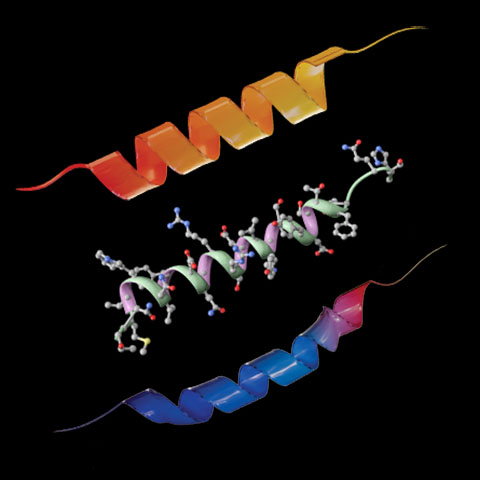
Increasingly versatile peptide drugs for diabetes
Diabetes affects an estimated 37 million Americans. The disease affects the body’s control of circulating sugar, usually through changes in tissue responses to insulin.
Incretins, peptide hormones that influence insulin secretion, have emerged in recent decades as drug targets for diabetes. Glucagon-like peptide 1 receptor agonists, peptide drugs that mimic the incretin GLP-1, improve glycemic control among diabetic patients. But they are less effective than the much more invasive treatment of bariatric surgery, which leaves pharmaceutical researchers wondering whether these drugs can be improved.
Scientists have looked to other incretins, beginning with glucose-dependent insulinotropic polypeptide, or GIP. GLP-1 and GIP have a similar alpha-helical structure and significant sequence overlap, and both are released from the gastrointestinal tract to reduce circulating glucose by stimulating insulin secretion.

This year, the U.S. Food and Drug Administration approved the first peptide drug that works as a bifunctional agonist of both GLP-1 and GIP receptors. The drug, tirzepatide, causes weight loss and improves cardiometabolic and glycemic outcomes in diabetic patients. Its amino acid sequence, based on GIP, is engineered to bind both GIP and GLP-1 receptors, with modifications to boost its half-life by reducing its susceptibility to proteases and improving its binding to albumin.
Meanwhile, industrial research labs are looking to expand from bifunctional to trifunctional peptide drugs that target GLP-1, GIP and also glucagon receptors. Adding glucagon to the mix is expected to have complementary effects on glycemic control, obesity and diabetes. Researchers at Eli Lilly and Company wrote in a statement to ASBMB Today, “Our hypothesis considers that GLP-1 reduces appetite and GIP enhances GLP-1-induced reduction of appetite and glucagon enhances energy expenditure and combination of all those effects may produce more weight loss.”
This year, two papers published in the journal Cell Metabolism reported on trifunctional agonists that can activate all three receptors. Both drugs’ sequences use insights from alignment and 3D structural examination to merge the features of each peptide that are important for receptor binding and balance potency against all three receptors. In obese mice and monkeys, the triple agonists reduced body weight even in animals that lacked the GLP-1 receptor.
Both drugs were tested in humans in small preliminary trials. Sanofi discontinued work on its drug in 2019 after the preliminary human trial; Eli Lilly has continued to develop its drug, with two effectiveness and safety trials set to begin this year. These may be the first of many; in their paper, the Lilly scientists observed that “targeting all 3 of these receptors has evolved into the next generation of drug development for treatment of T2D and obesity.”
Enjoy reading ASBMB Today?
Become a member to receive the print edition four times a year and the digital edition monthly.
Learn moreGet the latest from ASBMB Today
Enter your email address, and we’ll send you a weekly email with recent articles, interviews and more.
Latest in Opinions
Opinions highlights or most popular articles

Debugging my code and teaching with ChatGPT
AI tools like ChatGPT have changed the way an assistant professor teaches and does research. But, he asserts that real growth still comes from struggle, and educators must help students use AI wisely — as scaffolds, not shortcuts.

AI in the lab: The power of smarter questions
An assistant professor discusses AI's evolution from a buzzword to a trusted research partner. It helps streamline reviews, troubleshoot code, save time and spark ideas, but its success relies on combining AI with expertise and critical thinking.

How AlphaFold transformed my classroom into a research lab
A high school science teacher reflects on how AI-integrated technologies help her students ponder realistic research questions with hands-on learning.

Writing with AI turns chaos into clarity
Associate professor shares how generative AI, used as a creative whiteboard, helps scientists refine ideas, structure complexity and sharpen clarity — transforming the messy process of discovery into compelling science writing.

Teaching AI to listen
A computational medicine graduate student reflects on building natural language processing tools that extract meaning from messy clinical notes — transforming how we identify genetic risk while redefining what it means to listen in science.

What’s in a diagnosis?
When Jessica Foglio’s son Ben was first diagnosed with cerebral palsy, the label didn’t feel right. Whole exome sequencing revealed a rare disorder called Salla disease. Now Jessica is building community and driving research for answers.

